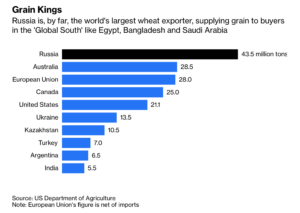The USDA is projecting that the ag trade deficit will shrink in FY2026 even more than previously anticipated. USDA expects the trade deficit to fall from $43.7 billion in FY2025…
“Farming Marshall Plan” Needed For Ukraine, as Wheat Variables Garner Attention
Wall Street Journal writers Patrick Thomas and Alistair MacDonald reported today that, “Foreign countries and some of the world’s largest agriculture companies are donating or lending hundreds of millions of dollars to Ukrainian farmers, marking an early push by Kyiv’s allies to rebuild the country even as the war shows little sign of ending soon.
“Ukraine’s farming industry has been hit hard by Russia’s invasion. Equipment has been destroyed, land has been expropriated and mined and export routes choked off. Financing is hard to come by, and some of the industry’s most basic imports, such as fertilizer, are in short supply.
In response, Western nations and companies are pouring in aid. For Western allies, the funding represents a small down payment on what experts think will be hundreds of billions of dollars worth of reconstruction aid required over years.
The Journal article noted that, “The government and commercial assistance ‘will give a possibility for Ukraine to move in the correct direction,’ said Mykola Solskyi, Ukraine’s minister of agrarian policy and food. He said for the sector to fully recover it will need the equivalent of a farming Marshall Plan, a reference to the aid program that helped rebuild Europe after World War II.”
Thomas and MacDonald added that, “Agriculture executives say they expect this year’s harvest in Ukraine to be down roughly 30% from a typical year. Ukrainian officials have said they expected its farmers to harvest up to 15% less grain this year than last.”
Bloomberg News reported last month that, “Farmers are cutting fertilizer use, idling land and switching to cheaper-to-grow oilseeds — all of which risk slashing grain output by a fifth from last year’s already-low level.”
Meanwhile, Bloomberg writer Jen Skerritt reported yesterday that, “Parts of the Canadian Prairies have experienced the second-driest start to a year in 45 years, said David Streit, senior meteorologist at Commodity Weather Group. Swaths of key spring wheat regions including Alberta, Saskatchewan and Manitoba have received less than 60% of average precipitation since Sept. 1, according to Canada’s agriculture ministry.”
“Canada is the world’s top canola grower and a major wheat exporter. Drought fears in Canada come amid continued uncertainty about wheat exports from the Black Sea region and as dry conditions in parts of the US threaten to cut output.”

Also yesterday, DTN Managing Editor Anthony Greder reported that, “The severe drought conditions plaguing the Southern Plains were reflected in USDA NASS’s first national winter wheat condition rating of the season.
“In its first weekly national Crop Progress report of 2023 released on Monday, NASS estimated U.S. winter wheat condition at just 28% good to excellent, below the previous decade-plus low of 30% last year at this time. And with dry, windy conditions expected in the region the rest of this week, the crop appears unlikely to see much relief anytime soon, according to DTN forecasts.”
“Top winter-wheat producer Kansas‘ crop was rated just 16% good to excellent with 57% rated very poor to poor, noted DTN Senior Analyst Dana Mantini.”
This week's winter #wheat condition index scores tie year ago levels for the second lowest on record (1987) for this week of the growing season. #oatt pic.twitter.com/NDaXdtKROg
— Arlan Suderman (@ArlanFF101) April 3, 2023
Reuters columnist Karen Braun pointed out today that, “USDA on Friday estimated U.S. winter wheat plantings for the 2023 harvest at an eight-year high of 37.5 million acres, up from 33.3 million last year, driven by elevated wheat prices last fall. This should in theory help lift domestic wheat stocks, which were at 15-year lows for the date as of March 1.
“But conditions in some of the top states, where acres are up on the year, are concerning. Drought had curbed winter wheat production in 2022, and although drought is less widespread now versus a year ago, it has intensified in the hard red winter wheat (HRW) focused southern Plains.”

Reuters writers Mayank Bhardwaj and Rajendra Jadhav reported yesterday that, “India has been planning to relax norms to procure wheat from farmers amid untimely rainfall and hail which damaged the crop just before harvesting in key producing central and northern states, government officials and traders told Reuters.
“The world’s second biggest wheat producer plans to buy 34.15 million tonnes of new-season wheat from local farmers to shore up state reserves after purchases dropped 53% last year to 18.8 million tonnes because of a poor harvest.”

In other news, Reuters reported yesterday that, “Louis Dreyfus Company will stop exporting Russian grain from July 1, the group said on Monday, joining other global merchants in dropping activities in the world’s biggest wheat-exporting country.”

And Andrew Jeong reported in today’s Washington Post that, “David Beasley, the head of the U.N.’s World Food Program, took off his mask to offer a broad smile as he accepted the Nobel Peace Prize on behalf of his agency in 2020. At the time, he said that more than 270 million people were ‘marching toward starvation.’
“That figure is now up to 350 million people, Beasley has said in media interviews this week as he prepares to step down from the position on April 4 — a number larger than the population of the United States. ‘I thought we could put the World Food Program out of business’ when he took the job in 2017, he said in an interview with the BBC broadcast Friday.
“The food crisis ‘is going to get worse,’ he added. Climate change, the coronavirus pandemic and the war in Ukraine are all to blame, he said.”





